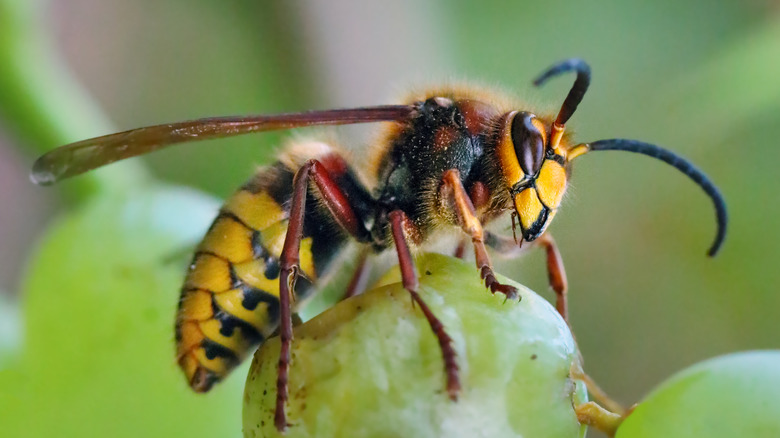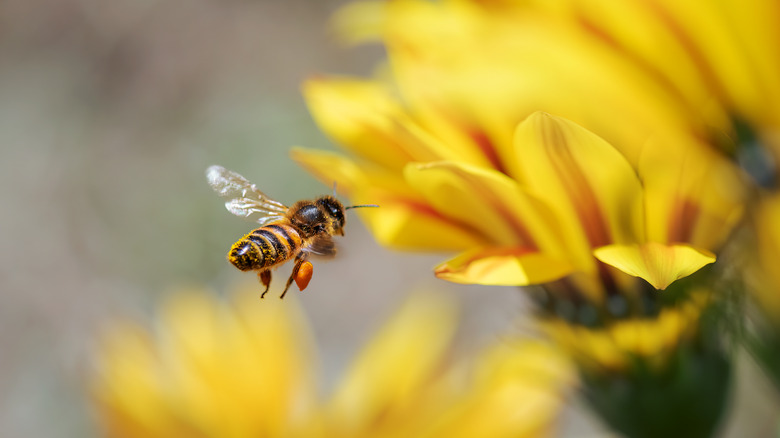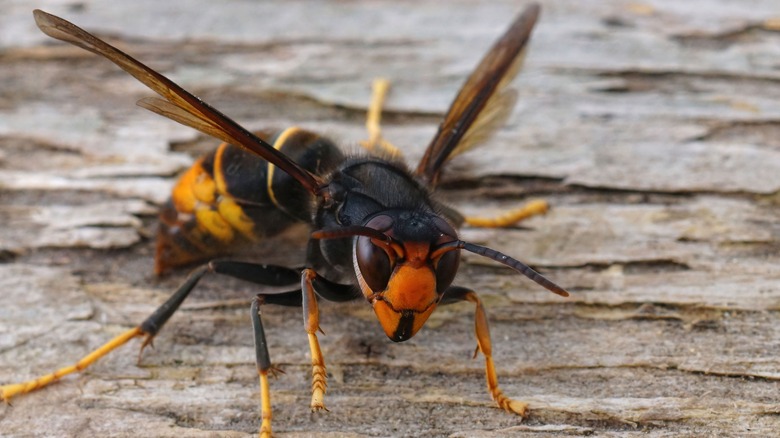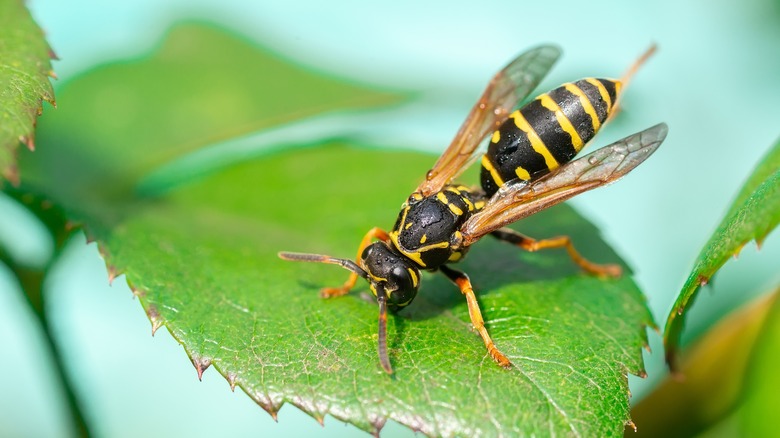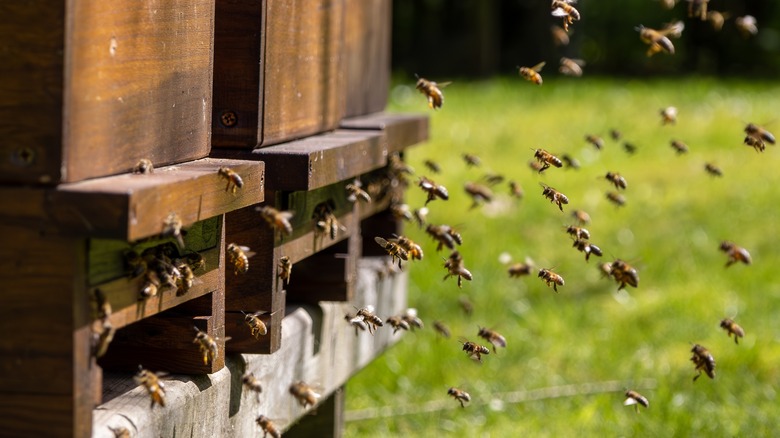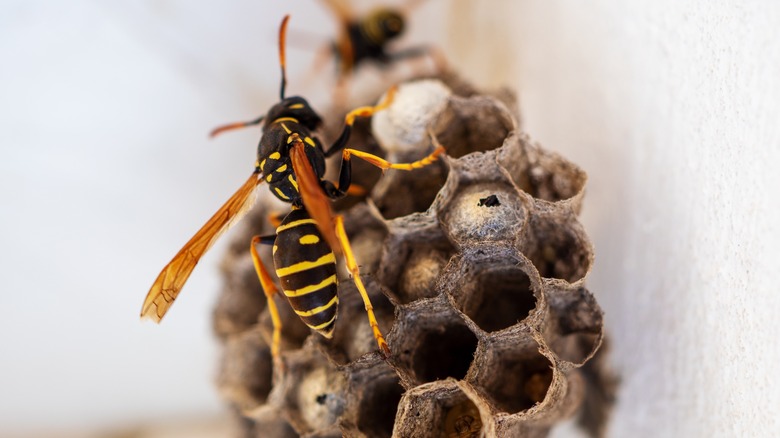Bees Vs. Hornets Vs. Wasps: What's The Difference?
While bees, wasps, and hornets may seem like interchangeable buzzing threats, these insects, which go by the Latin name Hymenoptera, have evolved distinct roles within the ecosystem. Their evolutionary paths diverged over 100 million years ago, shaping their appearances and behaviors.
Bees, the beloved pollinators, are easily identified by their fuzzy bodies. As bees flit from flower to flower, their specialized hairs collect pollen, a crucial food source for their young and the raw material for honey production. In contrast, wasps and hornets are the lean, hunting machines of the insect world. Their smooth, slender bodies and narrow waists are built for agility, allowing them to chase down prey like insects and spiders. This difference in diet is reflected in their body types — bees, the vegetarians, need pollen-collecting tools, while wasps and hornets, the carnivores, need a streamlined build for hunting. Interestingly, despite their fearsome reputation, only female wasps, bees, and hornets possess stingers, using them for defense and capturing prey.
Bees as pollinators
Unlike wasps and hornets, bees are fuzzy pollinators with a round body built for collecting pollen. Their legs act like pollen pockets, while wasps and hornets have smooth bodies better suited for hunting prey. This is reflected in their diet: bees are vegetarians, gathering nectar and pollen to feed their young and produce honey, while wasps and hornets are carnivores, hunting insects and spiders. Socially, bees are highly organized. Bees live in large hives with a queen, worker bees, and drones, while wasps and hornets typically have smaller colonies or live alone. Worker bees take on specific tasks, while wasps and hornets are more independent hunters.
Bees have barbed stingers that get stuck in the skin when they sting, often leading to the bee's death. Wasps and hornets have smooth stingers, allowing them to sting repeatedly. Some bees are more dangerous than others. However, the most dangerous bee in the animal kingdom is the Africanized killer bee.
How hornets differ to bees and wasps
Hornets share some similarities with both bees and wasps, but key differences set them apart. Hornets are much larger than bees and wasps and, as such, make a much louder buzzing sound. Specifically, murder hornets can grow to up to two inches in length. Their round bodies, often sporting black and yellow stripes like bees, can be deceiving. Unlike bees, hornets lack the fuzzy coat and pollen-collecting leg hairs. This reflects their dietary difference — bees are vegetarians, gathering nectar and pollen, while hornets are carnivores, hunting insects and spiders. Socially, hornets fall somewhere between bees and wasps. They form colonies with a queen and worker hornets, similar to bees. However, their colonies are smaller and less organized compared to beehives.
Like wasps, hornets have smooth stingers that retract after stinging, allowing them to attack repeatedly. Additionally, unlike bees whose barbed stingers detach upon stinging, hornets retain their stingers, further increasing their offensive capabilities.
Wasps compared to bees and hornets
Wasps are the lean hunters of the bunch. Their slender bodies with pinched waists and smooth exoskeletons are built for agility, allowing them to chase down prey like insects and spiders. This makes them great for pest control. Socially, wasps are the loners of the group. Unlike the highly organized hives of bees and the smaller, queen-led colonies of hornets, most wasps are solitary. They build individual nests and hunt independently.
The most significant difference lies in their stingers. Bees have barbed stingers that get lodged in the skin upon stinging, often leading to the bee's death. Wasps, like hornets, have smooth stingers that retract, allowing them to sting repeatedly. This makes wasp stings potentially more bothersome than bee stings. Additionally, unlike hornets, whose larger size makes them more intimidating, wasps come in a wider variety of shapes and sizes, making them the most diverse of the three.
The similarities between bees, wasps, and hornets
Despite their reputations, bees, hornets, and wasps are surprisingly close cousins. All belong to the Hymenoptera family, recognizable by their telltale four membranous wings and wasp-waisted figures. This means that their wings are thin and more or less transparent. Females of all three species wield stingers, modified from their egg-laying organs, for defense and hunting. On top of this, many species form complex societies with distinct roles. Honeybees have their queen, worker bees, and drones, while hornets and some wasps have queens and worker castes.
All are skilled architects, constructing impressive nests. Worker bees have special glands in their abdomens that produce wax scales. These scales are like tiny building blocks, chewed and manipulated by the bees to form the intricate honeycomb structure within their hive. Wasps and hornets, on the other hand, are resourceful architects who don't rely on pre-made materials. They create a paper-like substance by collecting wood fibers from fences, logs, or even cardboard. With their strong mandibles, they chew these fibers into a pulp, mixing it with their saliva as a natural glue. This wasp paper-mâché is then skillfully shaped and molded to form their nests.
The importance of bees, wasps and hornets for the environment
Despite their reputation for being picnic spoilers, bees, hornets, and wasps are actually vital players in keeping our environment healthy. Bees are essential for plant reproduction. But many wasp species also play this crucial part, unintentionally spreading pollen as they go about their business, ensuring a rich tapestry of plant life. Beyond this, these insects act as nature's pest control patrol. They prey on garden menaces like caterpillars and aphids, keeping these populations in check and protecting our crops and plants.
But the importance of bees, hornets, and wasps goes even deeper. They form a vital link in the food chain, serving as a delicious meal for birds, lizards, and other insectivores. Hornets and some wasps play a role in cleaning up nature's debris. They scavenge for carrion and other decaying matter, accelerating decomposition and contributing to the vital process of nutrient cycling. Bees, hornets, and wasps quietly maintain a healthy and balanced environment for all of us.
